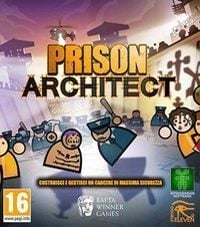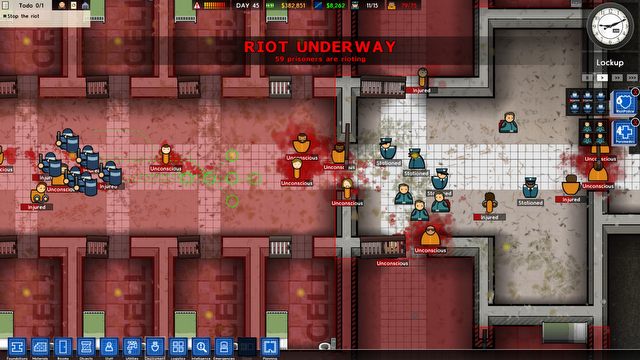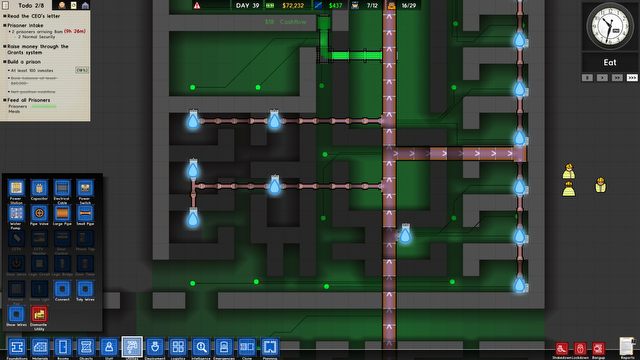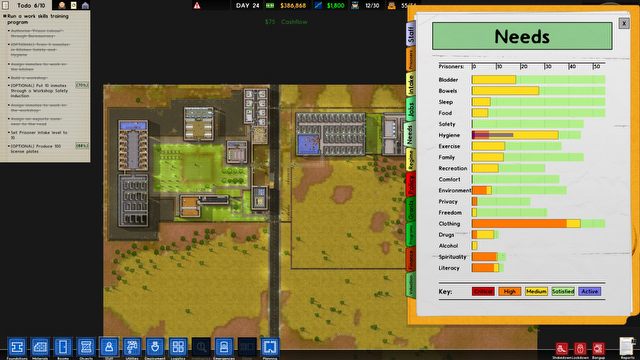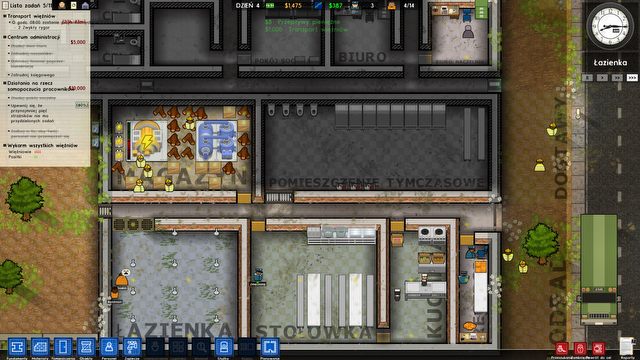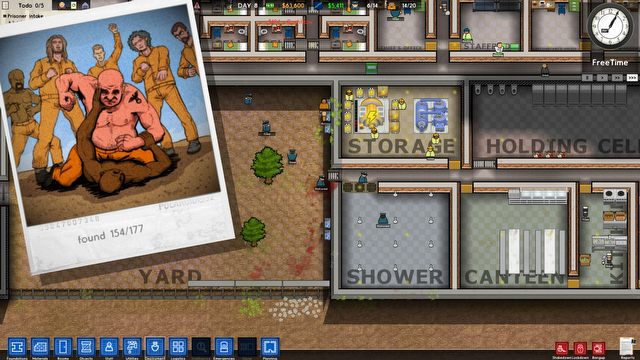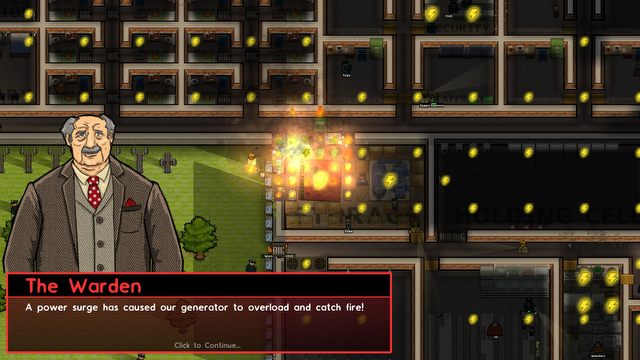Prison Architect Review – one of the best economic simulation games of recent years
Prison Architect is not friendly to new users, requires patching of numerous errors, and provides a disappointing campaign but its key elements – construction and management – are amazingly executed.
The review is based on the PC version.
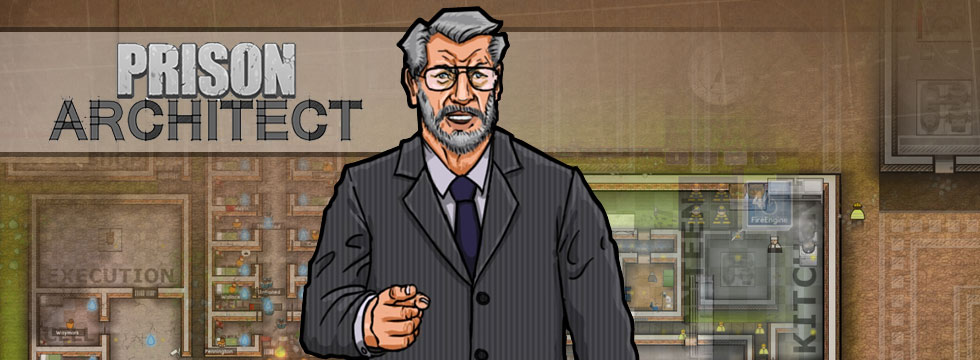
- Great complexity of prison life simulation;
- It's as addictive as the best representatives of the genre;
- Random events significantly enrich the sandbox sessions;
- Support for mods and the sizeable fan community give hope for a long life of the production.
- Numerous bugs;
- Escape mode is just a fun element sufficient for a dozen minutes;
- Disappointing campaign.
Prison Architect, the newest child of Introversion Software studio, had been stuck in the early access program for so long that some people began to doubt whether its final version would finally see the light of day. Although subsequent editions appeared regularly, correcting mistakes and introducing interesting new features, we had to wait for the final edition, containing more than just the sandbox mode, for more than three years since the debut of a playable beta. In the end, the final product holds together, although those who have already waited so long might consider waiting a little longer until the developers deal with the massive amount of shortcomings.
Alcatraz 2.0
The work of Introversion Software is an economic simulator allowing us to build and manage a private prison facility. In comparison to other tycoons, Prison Architect stands out mostly thanks to its complexity – not only can we build an ideal prison, e.g. by taking care of the distribution of lamps in prison cells, but we also have a huge impact on the treatment of prisoners, ranging from planning their daily schedule and determining the level of punishment for bad conduct to organizing therapy sessions for alcoholics and changing the type of food served. The ultimate goal is to create a safe facility characterized by a high rehabilitation rate, which is able to accommodate as many convicts as possible while generating a high profit.
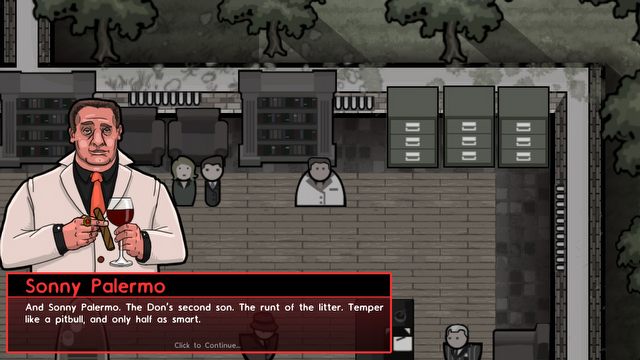
During a cutscene showing a mob family, the music played in the background bears a striking resemblance to the famous motive from “The Godfather”.
Before this all happens, however, we start modestly. The initial financial resources barely suffice to create one large cell for all convicts, a kitchen, a canteen and showers, as well as hire a handful of guards. As we take in further prisoner transports and receive larger funds from the state, we can invest in separate, individual cells, create an exercise yard, and provide entertainment. Over time, we employ administrative staff, thus gaining new options, have the inmates carry out various tasks at the prison, and try to ensure their rehabilitation. We must also take care of the diverse needs of convicts as discontent can quickly become a full-fledged rebellion.
Most of these tasks are performed simply by building and furnishing premises of various use. If we create a kitchen and an adjacent dining area, the cooks, provided they had been previously employed, will be assigned to work there by artificial intelligence; the same goes for directing the prisoners to these premises at the right time. Similarly, once we create a bathhouse, we don't have to worry about it anymore – the convicts will get there themselves. Basically, a decent, well-functioning prison can be created by simply building new facilities and hiring enough staff.
However, the true depth of Prison Architect is revealed when we decide to tinker with the less obvious options. For example, we can equip some cells better than others, making the transfer there a prize for the best-behaving prisoners – and encouragement for the more unruly ones. Or we can make the solitary confinement for any transgressions so long that any potential trouble-maker will think twice before misbehaving. Perfectionists will spend a lot of time searching for and eliminating all sources of contraband, whereas those who enjoy modifying the daily schedule will quickly see that eight hours of sleep are totally unnecessary and all this precious time can be put to much better use, e.g. inmates can get down to hard work and thus increase the income of our facility.
Welcome to Shawshank
Because of this complexity, Prison Architect may be confusing at first. We are introduced to the business of prisoner rehabilitation throughout a five-mission campaign which is actually a tutorial with a plot. We start from a task already known from the beta version in which we take part in preparing an electric chair room, then we witness a "family quarrel" between mafia members and we are finally forced to quell a riot. Every subsequent board gives us greater freedom of action and allows us to become familiar with other aspects of this business.
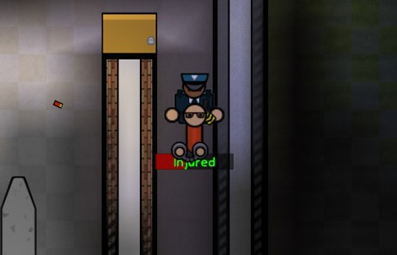
The escape mode which had been surrounded by quite some hype shortly before the release of the final version of the game is not very impressive and can only be entertaining for several dozen minutes tops. The premise is great – we assume the role of one of the convicts and get behind the walls of our prison (or one downloaded from Steam Workshop), seeking a way to escape. By causing a ruckus we gain reputation points which we then invest in increasing our own statistics or use to recruit new members of our gang. Once we’re strong enough, it’s time to make the great escape – by starting riots or secretly digging an underground tunnel. Sounds like fun. It’s a shame, though, that this entire aspect has been developed half-heartedly and doesn't really work like it should – our character doesn't need to eat, shower or sleep, and can ignore the daily schedule without any consequences. Escaping even the most secure facility is extremely easy, and once we collect and invest some reputation points we are able to wreak chaos and destruction in the prison just like the main character of Postal. The discussed mode is available in the extras menu – and this is exactly what it is, merely a small addition.
Unfortunately, standing somewhere between telling a story and teaching the basics of the game, the campaign is basically a failure on both accounts. The individual missions, although definitely useful in learning how to play, often focus on things that are irrelevant from the point of view of gameplay while omitting or leaving for much later the aspects necessary for the proper functioning of the prison. For example, the option to resize a daily transport of new prisoners, one of the most frequently used options in the game, isn't discussed until one of the final tasks while subsequent "deliveries" are active much earlier, and a novice player unaware of this factor can easily overpopulate their prison. I also managed to starve to death almost all prisoners while I calmly dealt with objectives of little importance from the point of view of existence of the institution. At the same time, the prison available for this task lacked a functioning canteen, as it turned out a little too late. The game never bothered to inform me about it. Or the fact that that I even needed such premises in the first place. In the end, completing all five missions allows us to become familiar with most aspects of the game, but we still have to experiment and learn from our mistakes before we can finally create a fully efficient prison.
In contrast, the stories constituting the background for our tasks are short and most often lack a satisfactory ending or a greater level of continuity. The characters we meet in one mission are quickly gone never to be seen again or only appear briefly, whereas a corruption scandal revealed at some point is quickly swept under the rug and then forgotten. It’s the more disappointing as these short fragments of the story that we’re shown demonstrate that the method of narration using clichés, implemented by the creators, works well and could successfully provide a basis for an interesting story. The entire production makes us ponder on whether prison system should serve as punishment for criminals or rather a source of rehabilitation. The story mode isn't helped either by the fact that it is only enough for one or two evenings tops – and only if we want to perform all the optional objectives. For a tycoon genre, it's a terribly weak outcome.
Crime, punishment and rehabilitation
Luckily for us, the sandbox mode makes up for the shortcomings of the too short campaign with a vengeance. Prison management is not a simple task; from the very beginning we struggle with a constant lack of cash. The solution to this problem is to increase the capacity of the prison, but the more prisoners we accommodate, the more difficult it becomes to control them – the displeased ones start riots while the ones not guarded properly begin to murder each other, smuggle weapons and drugs, and dig underground tunnels to gain freedom. A certain facilitation, as well as additional motivation for people who are not easily satisfied only by building a prison, comes in the form of a system of subsidies – at the moment we can activate several tasks the completion of which will be awarded with cash inflow.
The more advanced players can also enjoy the presence of gangs, turned off by default, and a system of random events, which provide further challenges. All of this is as addictive as the best representatives of the genre, especially once we activate all factors making the game more difficult, because in the worst possible moment we may experience a power generator fire or an epidemic. The only element of gameplay mechanics I have some reservations about is the severely limited option of accelerating the time of the game. In theory, we can choose one of three speeds, but the difference between the slowest and the fastest is small, and if we're currently looking forward to an inflow of cash or performance of a task required to get a donation, this could be a terrible drag.
Not all bugs present in the beta have been repaired in the full version. Detecting routes by prisoners and staff doesn't always work as it should – construction workers often use "shortcuts" leading through walls; sometimes doctors get stuck on a wall on their way to a patient and we must direct them manually to the target. I once encountered a more serious problem, which almost led to a serious riot. After a power generator fire, even though it was no longer a threat, my workers refused to approach the damaged machine and fix it, claiming it was too dangerous. The prison, deprived of power and water, was on the brink of a massive rebellion, and it wasn't until I saved and reloaded the game that I was able to prevent the massacre in the nick of time.
Although the campaign mode was a big disappointment and the game could use some polishing here and there, Prison Architect is still one of the best economic simulation productions of the recent years. The wide variety of options, high level of complexity, and in most cases smoothly working artificial intelligence of the "people" we operate make the time we spend with the production developed by Defcon and Darwinia creators pass very quickly; a brief evening session can easily become an all-nighter. What's more, the large community centered on Prison Architect and the game's openness to mods raises hopes that even if developers cease to support their child once it's finally patched, the fans will continue to provide additional attractions. This is a must-have for fans of the genre, although refraining from purchase until one or two patches are released certainly won’t hurt.
Prison Architect
Prison Architect Review – one of the best economic simulation games of recent years
Prison Architect is not friendly to new users, requires patching of numerous errors, and provides a disappointing campaign but its key elements – construction and management – are amazingly executed.
